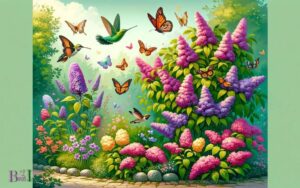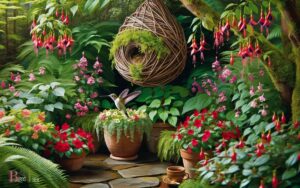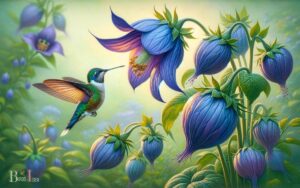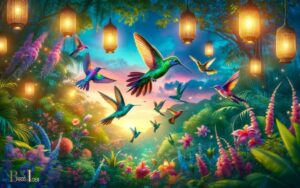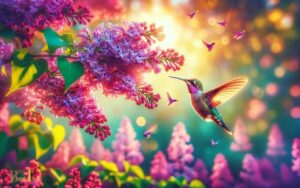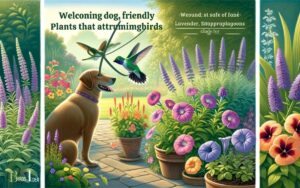Fall Flowers That Attract Hummingbirds: Discover!
Fall flowers that attract hummingbirds include vibrant bloomers such as bee balm, canna, salvia, and fuchsia. These flowers provide the rich nectar that hummingbirds need as they prepare for migration.
Hummingbirds are attracted to flowers with high nectar content, especially those in shades of red, pink, and orange.
During the fall, these tiny birds are preparing for their long migration journey and need to consume more energy. Certain flowers are particularly good at providing this energy boost.
Some of the best fall flowers for hummingbirds include:
Planting these flowers not only adds beauty to a garden but also supports the local hummingbird population.
Plant fuchsia and salvia in your autumn garden to create a hummingbird haven and enjoy the flurry of activity as these birds fuel up for migration.
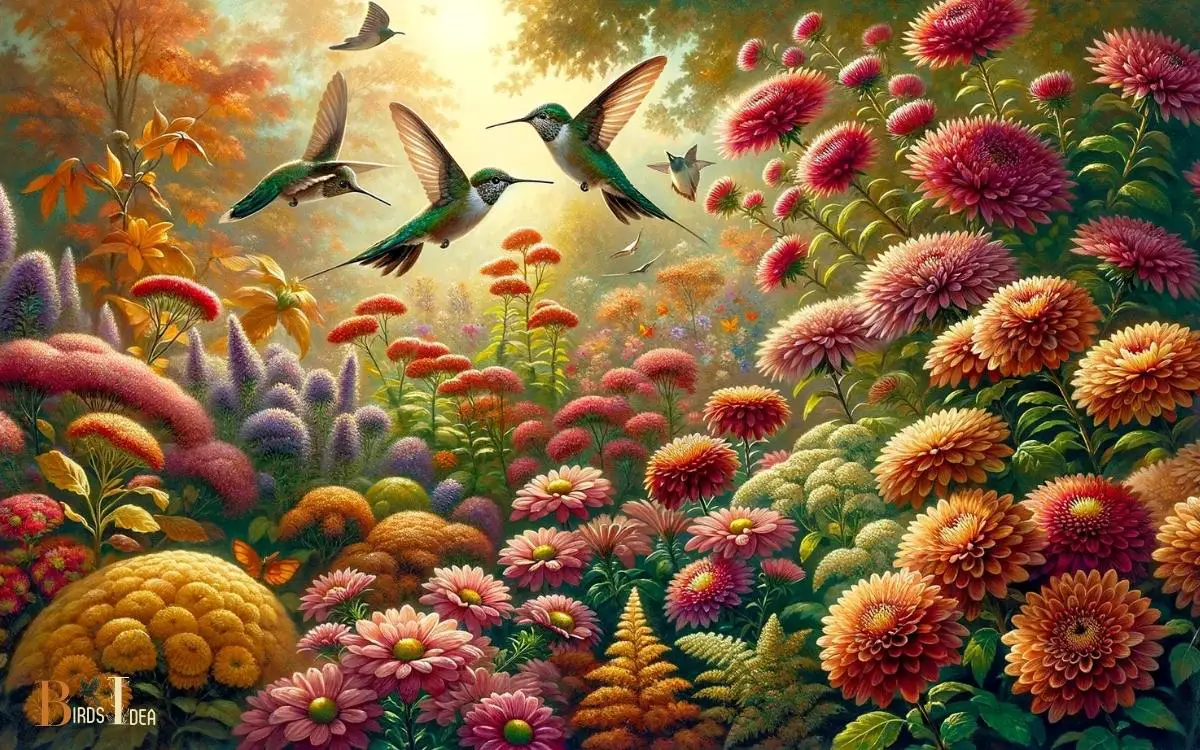
Key Takeaway
Importance of Fall Flowers for Hummingbirds
The importance of fall flowers for attracting hummingbirds is often underestimated. As the summer blooms begin to fade, fall flowers play a vital role in providing nectar for migrating hummingbirds.
These tiny birds rely on the energy-rich nectar to fuel their long journey south for the winter. Without an adequate food source, they may struggle to complete their migration, impacting their survival and population numbers.
By understanding the significance of fall flowers, individuals can contribute to the well-being of these remarkable birds.
Planting a variety of late-blooming flowers can help sustain hummingbirds as they prepare for their journey.
Characteristics of Hummingbird-Attracting Flowers
Hummingbird-attracting flowers typically have bright, tubular blooms that are well-suited for the birds’ long, slender bills.
These flowers are also rich in nectar, providing the essential energy source for hummingbirds.
Additionally, they often have a long blooming period, ensuring a consistent food source for the birds throughout the fall season.
Bright, Tubular Blooms
With their brightly colored, tubular blooms, fall flowers serve as a magnet for hummingbirds, attracting these tiny birds with their nectar-rich blossoms.
The characteristics of these bright, tubular blooms make them especially attractive to hummingbirds:
- Bright Colors: Hummingbirds are drawn to vibrant, eye-catching colors such as red, orange, and pink. These colors stand out in the landscape and signal the presence of nectar.
- Tubular Shape: The elongated, tubular shape of the flowers allows hummingbirds to easily insert their long, slender beaks to reach the nectar hidden within.
- Abundant Nectar: Fall flowers often produce ample amounts of nectar, providing the energy-rich sustenance that hummingbirds need, especially as they prepare for migration or the approaching winter.
- Long Blooming Period: Many fall flowers with bright, tubular blooms have a long blooming period, ensuring a sustained food source for visiting hummingbirds.
Rich in Nectar
Hummingbird-attracting flowers that are rich in nectar are essential for sustaining these energetic birds.
Below is a table highlighting some common fall flowers that are rich in nectar and known to attract hummingbirds:
| Flower | Nectar Richness | Color | Bloom Time |
|---|---|---|---|
| Trumpet Vine | High | Orange | Fall |
| Bee Balm | High | Red/Pink | Summer-Fall |
| Coral Honeysuckle | High | Coral/Red | Spring-Fall |
| Cardinal Flower | High | Red | Summer-Fall |
These nectar-rich flowers are sure to entice hummingbirds to your garden, providing them with the sustenance they need.
Long Blooming Period
These nectar-rich flowers with a long blooming period are particularly attractive to hummingbirds, providing sustained nourishment throughout the season.
The extended blooming period of these flowers increases the likelihood of attracting and feeding hummingbirds.
Characteristics of hummingbird-attracting flowers with long blooming periods include:
- Continuous Food Source: Flowers that bloom for an extended period offer a consistent food source for hummingbirds, ensuring they have access to nectar over an extended time.
- Increased Visibility: Long-blooming flowers are more likely to catch the attention of hummingbirds due to their extended presence in the garden or natural environment.
- Sustained Energy: The sustained blooming period of these flowers helps hummingbirds maintain their energy levels, supporting their active lifestyle.
- Consistent Garden Presence: Flowers with long blooming periods can help maintain the presence of hummingbirds in a garden throughout the season, creating a reliable spot for birdwatching enthusiasts.
Best Fall Flowers for Hummingbirds
Hummingbirds are attracted to vibrant fall flowers such as salvia, cardinal flower, and bee balm.
These flowers provide a rich source of nectar for hummingbirds as they prepare for migration or seek sustenance during the cooler months.
- Salvia, with its tubular blossoms, is a favorite of hummingbirds and comes in various shades of red, making it an eye-catching addition to any garden.
- Cardinal flowers, known for their brilliant red hue, are also highly attractive to hummingbirds.
- Bee balm, with its unique spiky flowers, is another popular choice that provides ample nectar.
These flowers not only add beauty to the fall garden but also serve as essential food sources for hummingbirds. Planting these fall flowers can create an inviting habitat for these delightful birds.
Planting Tips for Hummingbird-Friendly Gardens
To create a hummingbird-friendly garden, gardeners should select a variety of nectar-rich flowers that bloom throughout the fall season.
When planting a garden to attract hummingbirds, consider the following:
- Diverse Blooming Times: Choose flowers with staggered blooming times to ensure a continuous nectar supply for hummingbirds throughout the fall.
- Native Plant Species: Prioritize native plants as they are well-suited to the local climate and soil conditions, providing a more sustainable habitat for hummingbirds.
- Grouping Flowers: Planting clusters of the same flower species can make it easier for hummingbirds to locate and feed on the nectar.
- Strategic Placement: Position flowers near natural perches or in sunny spots to create inviting feeding areas for hummingbirds.
Maintenance and Care for Hummingbird-Attracting Flowers
Selecting low-maintenance plants and providing adequate watering are essential for ensuring the health and longevity of hummingbird-attracting flowers.
Opt for native plants as they are better adapted to the local climate and require less maintenance.
Deadheading, the removal of old flowers, encourages continuous blooming and keeps the plants looking tidy.
It’s also important to regularly inspect the plants for pests and diseases, addressing any issues promptly to prevent them from spreading.
When watering, aim to keep the soil consistently moist but not waterlogged, as this can lead to root rot.
Fertilize the flowers sparingly, as too much fertilizer can lead to excessive foliage growth at the expense of flowers.
By following these maintenance tips, gardeners can ensure that their hummingbird-attracting flowers remain healthy and vibrant, providing a welcoming environment for these delightful birds.
Designing a Hummingbird-Friendly Garden
When designing a garden to attract hummingbirds, it’s important to prioritize nectar-rich blooms and provide perches for resting.
By strategically selecting flowers that are rich in nectar, gardeners can create an enticing environment for hummingbirds.
Additionally, incorporating various perches throughout the garden will offer the tiny birds a place to rest and observe their surroundings.
Planting Nectar-Rich Blooms
A hummingbird-friendly garden requires a variety of nectar-rich blooms to attract these delightful birds.
When planning a garden to attract hummingbirds, consider the following:
- Diversity: Incorporate a wide range of flowers with different shapes, sizes, and colors to appeal to a variety of hummingbird species.
- Blooming Period: Select blooms that flower at different times throughout the season, providing a consistent nectar source for hummingbirds.
- Native Plants: Choose native flowers as they are adapted to the local environment and are more likely to attract native hummingbird species.
- Grouping: Plant clusters of the same flower species together to create prominent patches of color, making it easier for hummingbirds to spot and visit the blooms.
Providing Perches for Resting
To create a hummingbird-friendly garden, consider placing perches at various heights to provide resting spots for the birds.
Hummingbirds, despite their high-energy nature, need to rest periodically. Providing perches allows them to conserve energy and feel safe while surveying their surroundings.
Choose perches that are sturdy and stable, such as thin branches or decorative hooks, and position them near nectar-rich flowers and feeders.
These perches should be at different heights to accommodate the varying flight patterns of different hummingbird species.
Incorporating perches into the garden not only supports the birds’ need for rest but also allows for enjoyable bird-watching opportunities.
This strategic placement of perches will help create a welcoming habitat for hummingbirds, encouraging them to visit and linger in your garden.
Creating a Welcoming Habitat for Hummingbirds
Here are some simple steps to make your garden a haven for these delightful creatures:
- Plant native flowers: Choose a variety of native flowers that provide nectar, such as bee balm, cardinal flower, and trumpet vine. These flowers are rich in nectar and will attract hummingbirds to your garden.
- Provide water sources: Hummingbirds need water not just for drinking, but also for bathing. Consider adding a small water feature, such as a birdbath or a shallow fountain, to give them a place to bathe and drink.
- Offer perches: Place small sticks or thin branches near feeders and flowers to give hummingbirds a place to rest and observe their surroundings.
- Avoid pesticides: Minimize the use of pesticides in your garden, as these chemicals can be harmful to hummingbirds. Opt for natural pest control methods to keep your garden healthy and safe for these beautiful birds.
Conclusion
Fall flowers play a crucial role in attracting hummingbirds to gardens. According to the Audubon Society, hummingbirds visit an average of 1,000 flowers per day to feed on nectar, making them important pollinators for plants.
By planting the right flowers and creating a welcoming habitat, gardeners can help support these beautiful and vital creatures throughout the fall season.
Happy gardening!

